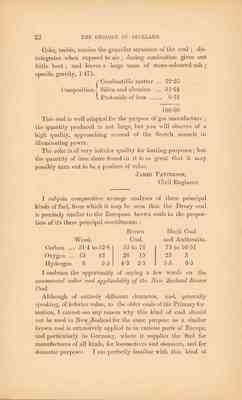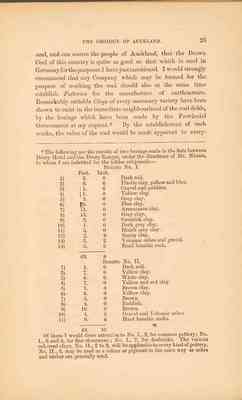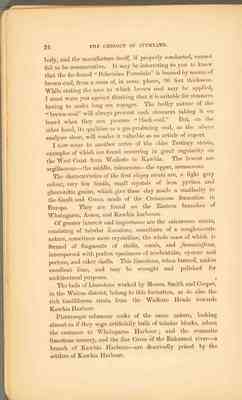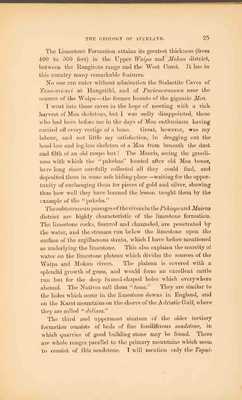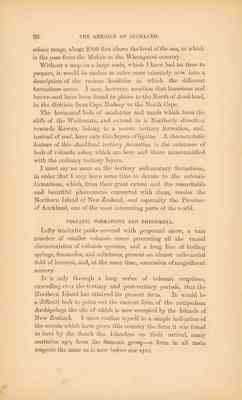Pages
22 THE GEOLOGY OF AUCKLAND.
Coke, trable, retains the granular structure of the coal; disintegrates when exposed to air; during combustion gives out little heat; and leaves a large mass of stone-coloured ash; specific gravity, 1∙471. ( Combustible matter ... 39∙25 Composition ) Silica and alumina ... 54∙44 ( Protoxide of iron ... .... 6.31 _____ 100∙00
The coal is well adapted for the purpose of gas manufacture; the quantity produced is not large, but you will observe of a high quality, approaching several of the Scotch cannels in illuminating power.
The coke is of very inferior quality for heating purposes; but the quantity of iron share found in it is so great that it may possibly turn out to be a product of value. JAMES PATTERSON, Civil Engineer. ______________
I subjoin comparative average analyses of three principal kinds of fuel, from which it may be seen that the Drury coal is precisely similar to the European brown coals in the proportion of its three principal constituents: Brown Black Coal Wood. Coal. and Anthracite. Carbon ... 51∙4 to 52∙6 55 to 76 73 to 96∙51 Oxygen ... 43 42 26 19 23 3 Hydrogen ... 6 5∙5 4∙3 2∙5 5∙5 0∙5
I embrace the opportunity of saying a few words on the commercial value and applicability of the New Zealand Brown Coal.
Although of entirely different character, and, generally speaking, of inferior value, to the older coals of the Primary for mation, I cannot see any reason why this kind of coal should not be used in New Zealand for the same purpose as a similar brown coal is extensively applied to in various parts of Europe, and particularly in Germany, where it supplies the fuel for manufactures of all kinds, for locomotives and steamers, and for domestic purposes. I am perfectly familiar with this kind of
THE GEOLOGY OF AUCKLAND 23
coal, and can assure the people of Auckland, that the Brown Coal of this country is quite as good as that which is used in Germany for the purposes I have just mentioned. I would strongly recommend that any Company which may be formed for the purpose of working the coal should also at the same time establish Potteries for the manufacture of earthenware. Remarkably suitable Clays of every necessary varieties have been shown to exist in the immediate neighbourhood of the coal-fields, by the borings which have been made by the Provincial Government at my request.* By the establishment of such works, the value of the coal would be made apparent to every________________________________________________________ * The following are the results of two borings made in the flats between Drury Hotel and the Drury Ranges, under the directions of Mr. Ninnis, to him I am indebted for the tables subjoined:- BORING No. I. Feet. Inch. 1) 2. 0 Dark soil. 2) 9. 6 Plastic clay, yellow and blue. 3) 1. 6 Gravel and pebbles. 4) 1. 0 Yellow clay. 5) 3. 0 Grey clay. 6) 6. 0 Blue clay. 7) 11. 0 Arenaceous clay. 8) 15. 0 Grey clay. 9) 2. 0 Greenish clay. 10) 1. 0 Dark grey clay. 11) 5. 0 Bluish grey clay. 12) 2. 0 Sandy clay. 13) 5. 2 Volcanic ashes and gravel. 14) 5. 6 Hard basaltic rock. ________ 69. 8 BORING No. II. 1) 1. 0 Dark soil. 2) 7. 0 Yellow clay. 3) 6. 6 White clay. 4) 7. 0 Yellow and red clay. 5) 1. 4 Brown clay. 6) 8. 0 Yellow clay. 7) 5. 0 Brown. 8) 4. 0 Reddish. 9) 10. 0 Brown. 10) 4. 6 Gravel and Volcanic ashes. 11) 9. 6 Hard basaltic rockss. ________ 63. 10 Of these I would draw attention to No. I., 2, for common pottery; No. I., 6 and 8, for fine stoneware; No. I., 7, for firebricks, The various coloured clays, No. II., 2 to 9, will be applicable to every kind of pottery. No. II., 8 may be used as a colour or pigment in the same way as ochre and umber are generally used.
24 THE GEOLOGY OF AUCKLAND.
body, and the manufacture itself, if properly conducted, cannot fail to be remunerative. It may be interesting to you to know that the far-famed "Bohemian Porcelain" is burned by means of brown-coal, from a seam of, in some places, 90 feet thickness. While stating the uses to which brown coal may be applied, I must warn you against thinking that it is suitable for steamers having to make long sea voyages. The bulky nature of the "brown-coal" will always prevent such steamers taking it on board when they can procure "black-coal." But, on the other hand, its qualities as a gas-producing coal, as the above analyses show, will render it valuable as an article of export.
I now come to another series of the older Tertiary strata, examples of which are found occurring in great regularity on the West Coast from Waikato to Kawhia. The lowest are argillaceous - the middle, calcareous - the upper, areaceous.
The characteristics of the first clayey strata are, a light grey colour, very few fossils, small crystals of iron pyrites and glauconitic grains, which give these clay marls a similarity to the Gault and Green sands of the Cretaceous formation in Europe. They are found on the Eastern branches of Whaingaroa, Aotea, and Kawhia harbours.
Of greater interest and importance are the calcareous strata, consisting of tabular limestone, sometimes of a conglomerate nature, sometimes more crystalline, the whole mass of which is formed of fragments of shells, corals, and foraminiferæ, interspersed with perfect specimens of terebratulæ, oysters and pectens, and other shells. This limestone, when burned, makes excellent lime, and may be wrought and polished for architectural purposes.
The beds of Limestone worked by Messrs. Smith and Cooper, in the Wairoa district, belong to this formation, as do also the rich fossiliferous strata from the Waikato Heads towards Kawhia Harbour.
Picturesque columnar rocks of the same nature, looking almost as if they were artificially built of tabular blocks, adorn the entrance to Whaingaroa Harbour; and the romantic limestone scenery, and the fine Caves of the Rakaunui river - a branch of Kawhia Harbour - are deservedly prized by the settlers of Kawhia Harbour.
THE GEOLOGY OF AUCKLAND. 25
The Limestone Formation attains its greatest thickness (from 400 to 500 feet) in the Upper Waipa and Mokau district, between the Rangitoto range and the West Coast. It has in this country many remarkable features.
No one can enter without admiration the Stalactite Caves of Tana-uri-uri at Hangatiki, and of Parianewanewa near the sources of the Waipa - the former haunts of the gigantic Moa.
I went into those caves in the hope of meeting with a rich harvest of Moa skeletons, but I was sadly disappointed, those who had been before me in the days of Moa enthusiasm having carried off every vestige of a bone. Great, however, was my labour, and not little my satisfaction, in dragging out the head-less and leg-less skeleton of a Moa from beneath the dust and filth of an old raupo hut! The Maoris, seeing the greediness with which the "pakehas" hunted after old Moa bones, have long since carefully collected all they could find, and deposited them in some safe hiding-place - waiting for the opportunity of exchanging them for pieces of gold and silver, showing thus how well they have learned the lesson taught them by the example of the "pakeha."
The subterranean passages of the rivers in the Pehiope and Mairoa district are highly characteristic of the limestone formation. The limestone rocks, fissured and channeled, are penetrated by the water, and the streams run below the limestone upon the surface of the argillaceous strata, which I have before mentioned as underlying the limestone. This also explains the scarcity of water on the limestone plateau which divides the source of the Waipa and Mokau rivers. The plateau is covered with a splendid growth of grass, and would form an excellent cattle run but for the deep funnel-shaped holes which everywhere abound. The Natives call them "tomo." They are similar to the holes which occur in the limestone downs in England, and on the Karst mountains on the shores of the Adriatic Gulf, where they are called "dolines."
The third and uppermost stratum of the older tertiary formation consists of beds of fine fossiliferous sandstone, in which quarries of good building stone may be found. There are whole ranges parallel to the primary mountains which seem to consist of this sandstone. I will mention only the Tapui-
26 THE GEOLOGY OF AUCKLAND.
whane range, about 2000 feet above the level of the sea, in which is the pass from the Mokau in the Whanganui country.
Without a map on a large scale, which I have had no time to prepare, it would be useless to enter more minutely now into a description of the various localities in which the different formations occur I may, however, mention that limestone and brown-coal have been found in places to the North of Auckland, in the districts from Cape Rodney to the North Cape.
The horizontal beds of sandstone and marls which form the cliffs of the Waitemata, and extend in a Northerly direction towards Kawau, belong to a newer tertiary formation, and, instead of coal, have only thin layers of lignite. A characteristic feature of this Auckland tertiary formation is the existence of beds of volcanic ashes, which are here and there interstratified with the ordinary tertiary layers.
I must say no more on the tertiary sedimentary formations, in order that I may leave some time to devote to the volcanic formations, which, from their great extent and the remarkable and beautiful phænomena connected with them, render the Northern Island of New Zealand, and especially the Province of Auckland, one of the most interesting parts of the world.
VOLCANIC FORMATIONS AND PHENOMENA. Lofty trachytic peaks covered with perpetual snow, a vast number of smaller volcanic cones presenting all the varied characteristics of volcanic systems, and a long line of boiling springs, fumaroles, and solfataras, present an almost unbounded field of interest, and, at the same time, succession of magnificent scenery.
It is only through a long series of volcanic eruptions, extending over the tertiary and post-tertiary periods, that the Northern Island has attained its present form. It would be a difficult task to point out the ancient form of the antipodean Archipelago the site of which is now occupied by the Islands of New Zealand. I must confine myself to a simple indication of the events which have given this country the form it was found to have by the South Sea Islanders on their arrival, many centuries ago, from the Samoan group - a form in all main respects the same as is now before our eyes.
